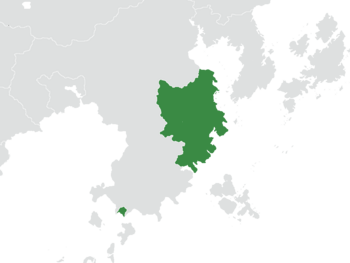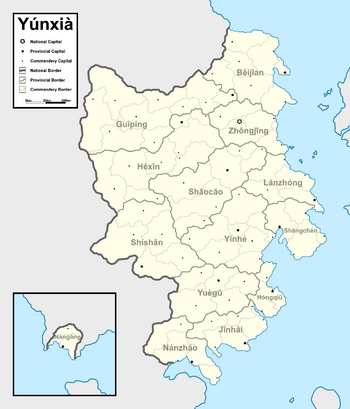Yunxia: Difference between revisions
mNo edit summary |
mNo edit summary |
||
| Line 28: | Line 28: | ||
|alt_map2 = | |alt_map2 = | ||
|map_caption2 = Map of Yunxia | |map_caption2 = Map of Yunxia | ||
|capital = [[ | |capital = [[Zhōngjīng]] | ||
|coordinates = <!-- Coordinates for capital, using {{tl|coord}} --> | |coordinates = <!-- Coordinates for capital, using {{tl|coord}} --> | ||
| languages_type = Official language</br>Regional languages | | languages_type = Official language</br>Regional languages | ||
| Line 94: | Line 94: | ||
The '''Republic of Yúnxià''' is a country in East Ochran. While ostensibly a constitutional republic, since 1944 the country has been governed by a military administration with devolved government along the lines of military districts and historic commandery districts. In practice, the regional governments are divided along cultural and geographic cliques, with significant warlordism beyond the core. Both reactionary and revolutionary elements exert significant influence across the country. The current head of the central government and the main Junting Army is Generalissimo Feng Zhixin. | The '''Republic of Yúnxià''' is a country in East Ochran. While ostensibly a constitutional republic, since 1944 the country has been governed by a military administration with devolved government along the lines of military districts and historic commandery districts. In practice, the regional governments are divided along cultural and geographic cliques, with significant warlordism beyond the core. Both reactionary and revolutionary elements exert significant influence across the country. The current head of the central government and the main Junting Army is Generalissimo Feng Zhixin. | ||
Through most of modern history, the country of Yunxia formed the core of the Shenzhou Empire, a preeminent power in East Ochran. By the early 20th century, the Empire was reduced to a rump state in Yunxia. In 1940, the Empire was overthrown and the Republic of Yunxia was founded. Its first president was subsequently removed in 1944 by a military coup after an attempt to restore the Empire. Initially, the military administration had popular support. Over subsequent decades, the authority of the military administration based in the capital of | Through most of modern history, the country of Yunxia formed the core of the Shenzhou Empire, a preeminent power in East Ochran. By the early 20th century, the Empire was reduced to a rump state in Yunxia. In 1940, the Empire was overthrown and the Republic of Yunxia was founded. Its first president was subsequently removed in 1944 by a military coup after an attempt to restore the Empire. Initially, the military administration had popular support. Over subsequent decades, the authority of the military administration based in the capital of Zhōngjīng has eroded in favour of local populist movements and militias. | ||
The economy of Yunxia is mixed both in terms of state interventions and development. In the vast hinterlands, a peasant agrarian economy is still commonplace. Closer to the capital, there is considerable industrial development with a focus manufacturing for an export market. The military administration has also designated a number of special international economic zones to promote financial services and foreign investment. | The economy of Yunxia is mixed both in terms of state interventions and development. In the vast hinterlands, a peasant agrarian economy is still commonplace. Closer to the capital, there is considerable industrial development with a focus manufacturing for an export market. The military administration has also designated a number of special international economic zones to promote financial services and foreign investment. | ||
Revision as of 22:11, 17 March 2024
This article is incomplete because it is pending further input from participants, or it is a work-in-progress by one author. Please comment on this article's talk page to share your input, comments and questions. Note: To contribute to this article, you may need to seek help from the author(s) of this page. |
Republic of Yúnxià | |
|---|---|
 Location of Yunxia (dark green) in East Ochran | |
 Map of Yunxia | |
| Capital | Zhōngjīng |
| Official language Regional languages | Xianese Dongese, Manzinese, Beian, Kitaganese, Tsurushimese |
| Demonym(s) | Yunxianese |
| Government | Presidential constitutional republic (de jure) Military administration (de facto) |
• Acting head of state | Generalissimo Fēng Zhīxīn |
• Legislature | National Council (suspended) |
| Establishment | |
• Republic of Yunxia | May 27, 1943 |
• Military administration | November 12, 1944 |
| Area | |
• Total | 1,096,990 km2 (423,550 sq mi) |
• Water (%) | 4.59 |
| Population | |
• 2024 census | 78,474,968 |
• Density | 71.5/km2 (185.2/sq mi) |
| GDP (nominal) | 2024 estimate |
• Total | $856 billion |
• Per capita | $10,905.31 |
| Gini | high |
| HDI (2024) | medium |
| Currency | Fēn (¥) (YXF) |
| Date format | yyyy-mm-d-dd |
| Driving side | right |
| Internet TLD | .yx |
The Republic of Yúnxià is a country in East Ochran. While ostensibly a constitutional republic, since 1944 the country has been governed by a military administration with devolved government along the lines of military districts and historic commandery districts. In practice, the regional governments are divided along cultural and geographic cliques, with significant warlordism beyond the core. Both reactionary and revolutionary elements exert significant influence across the country. The current head of the central government and the main Junting Army is Generalissimo Feng Zhixin.
Through most of modern history, the country of Yunxia formed the core of the Shenzhou Empire, a preeminent power in East Ochran. By the early 20th century, the Empire was reduced to a rump state in Yunxia. In 1940, the Empire was overthrown and the Republic of Yunxia was founded. Its first president was subsequently removed in 1944 by a military coup after an attempt to restore the Empire. Initially, the military administration had popular support. Over subsequent decades, the authority of the military administration based in the capital of Zhōngjīng has eroded in favour of local populist movements and militias.
The economy of Yunxia is mixed both in terms of state interventions and development. In the vast hinterlands, a peasant agrarian economy is still commonplace. Closer to the capital, there is considerable industrial development with a focus manufacturing for an export market. The military administration has also designated a number of special international economic zones to promote financial services and foreign investment.
Culturally, Yunxia is a multi-ethnic country, though the majority of the population belong to various Shen sub-ethnicities. The Xianese make up a majority with significant Dongese and Manzinese minorities. The Beian and Kitaganese make up more marginal regional minorities.
History
The historical Shenzhou Empire stretched across a large portion of East Ochran, formed from various Shen peoples and states across the region. The first dynasty of the Shenzhou Empire was formed semi-legendarily sometime in the mid-first millennium BCE and material culture recovered from that era attests the Empire was one of the first centralized states formed in human history. For the next millennium, the Empire existed in various forms with numerous dynastic changes often accompanied by periods of anarchy and warring provinces. Externally, the greatest rivals of the Shen were the Tsurushimese and the Kitaganese, who vied for commercial interests and territorial domination.
In the mid-10th century, the Shenzhou Empire came under threat from the Bayarids to the west. In the early 11th century, the Empire was ultimately conquered by the Bayarids and made a vassal state of the Khanate. The Bayarid Empire gradually collapsed over the 12th century and when the Shen reclaimed the Imperial throne, domestic historiography considered this yet another dynastic change.
By the 16th century, the Empire gained prominence as the terminus of the Jade Road, with trade flourishing following the stabilization of Uluujol to the west. This led to significant economic growth as well as technological and cultural exchange between Belisaria and Ochran.
Despite the size and power of the Shenzhou Empire in the first part of the early modern era, the country did not industrialize on a broad scale and by the 19th century the Empire saw its sphere of influence shrinking. This culminated in defeat in the First Cross Strait War at the end of the century. When the Empire failed in a revanchist war in the 1920s and 30s, the stage was set for the dissolution of the Empire and ultimately the foundation of the Republic of Tianxia following the abdication of the emperor at the end of the Shen Civil War (1936-1943).
The Republic of Yunxia was established on May 27, 1943, and Marshal Wú Kūn was acclaimed as the first president. Several months into his tenure as president, Wú launched a self-coup, refounding the Shenzhou Empire with himself as emperor. On November 12, 1944, the Junting Army toppled Wú and officially restored the republic, though a military government was instituted to restore order while the constitution was suspended. Since then, a succession of military dictators have ruled the country, interspersed with periods of instability and conflict between competing military and political cliques.

